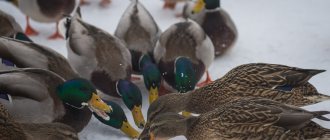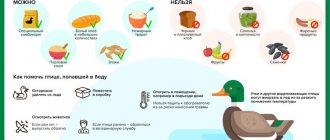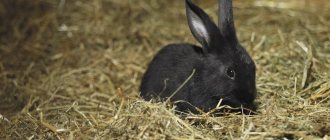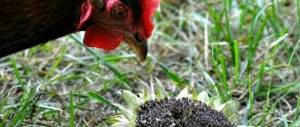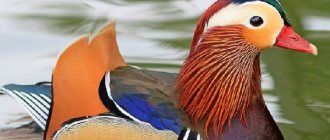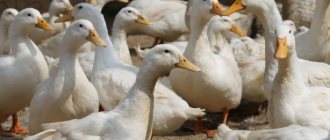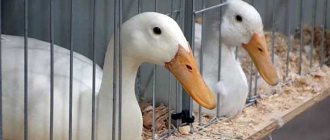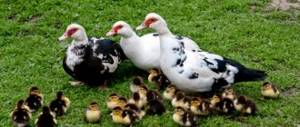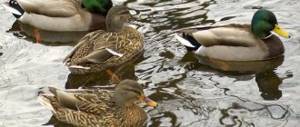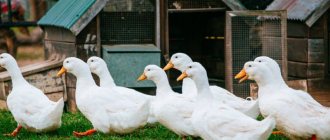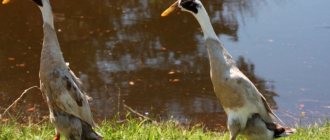What can you feed wild ducks: feeding them on the pond in winter
In zoos, waterfowl are fed specially prepared food in winter. They include all the nutritional elements (protein, carbohydrates, fats) that ducks can get from their usual food. But compassionate townspeople continue to feed the ducks remaining for the winter with baked goods and leftover bread.
Without receiving the necessary nutrients, the bird weakens and becomes more vulnerable to cold and disease. Trying to help starving waterfowl, people often cause irreparable harm to them. What to feed ducks in winter to really help them survive severe frosts?
It is advisable not to feed baked goods to the bird. The ducks will eat, but they won’t be able to get anything but harm from such food. You can prepare high-quality food for ducks of different species overwintering on a pond yourself. Its basis can be whole grain (oats, barley, wheat) or pearl barley, oatmeal, whole grain crushed grain (corn, barley, wheat).
Grain mixture
Protein components of bird feed can be as follows:
- fish or meat waste;
- egg;
- meat, fish, bone meal;
- bone residue in the form of minced meat (sold in grocery stores);
- peas;
- sunflower, soybean, rapeseed cake or meal;
- low-fat cottage cheese.
Meat or fish waste should not contain large bones. They can be fed raw or cooked. Before feeding, the egg should be hard-boiled and chopped together with the shell.
Protein components are mixed with grain feed. Grain for ducks can be pre-boiled or steamed, but in severe frosts it is better to give it dry so that the food does not have time to freeze. Whole grains can be sprouted before feeding until green sprouts 1-2 cm long appear. This food significantly increases the content of vitamins and biologically active substances that are lacking in the winter diet of birds.
But what should you feed wild ducks to enrich their diet with the fiber and vitamins they need? For waterfowl wintering in urban reservoirs, the following food can be prepared:
- dried nettle, clover, alfalfa, dandelion;
- any root vegetables;
- pumpkin or zucchini;
- fresh cabbage.
Ducks can be fed any root vegetables
Some vegetables need to be chopped before feeding. This applies to hard root vegetables and raw potatoes. Since birds do not have teeth, they will not be able to gnaw hard vegetables, and the flat beak of ducks does not allow them to peck carrots or beets. Therefore, all root vegetables with a dense structure must be grated or, raw or boiled, passed through a meat grinder. The same should be done with zucchini, pumpkin, and watermelon rind.
Leafy vegetables such as cabbage can also be given whole. The ducks do a good job of picking them off, tearing off small pieces. Dried herbs or bundles of hay are also not chopped.
As spring approaches, vegetables begin to sprout even in a cold cellar. Ducks will like young carrot or beet leaves. Trimmed tops of root vegetables or green feathers of onions and garlic will be very useful in the vitamin-poor winter diet of birds. If desired, you can specially germinate small root crops by planting them in a box with wet sand, sawdust, soil, and then feed the ducks with fresh herbs.
When preparing a winter diet for ducks, one should not forget about useful minerals. In natural conditions, it receives part of the calcium and phosphorus the bird needs from the bones of fish and frogs, shells of snails and crustaceans, which it feeds on in the pond.
It would be nice to give crushed egg shells
When artificial feeding, you can include crushed egg shells in the diet. It is also convenient to use feed chalk or shell rock (sold in pet stores). When meat and bone meal is included in the feed as a source of protein, additional mineral supplements are not necessary.
We should not forget about the special and important addition of gravel or coarse river sand for all birds. For ducks, the size of the pebbles can be about 0.5 cm
As such feeding, it is recommended to use marble chips, PGS, and natural river sand for the aquarium. Gravel for ducks can be added to the feed mixture in an amount of 5% of its volume or periodically poured into a special container. Pebbles help birds grind food in their stomachs.
They happily eat bread, seeds and other delicacies. But, despite the omnivorous nature of birds, some of the products can damage bird digestion.
You will learn about what you can feed wild ducks and what you cannot feed them in this article.
What's bad for ducks?
The most common species in water bodies are mallards. They are already so accustomed to people that they can easily feed from human hands.
You can't feed them bread. The crumbs pollute the water, stimulating the development of cyanobacteria. Watching a beautiful drake or a female beg for food, the question arises against your will: what to feed the ducks on the pond in the summer? And now all the available food is sent to the reservoir. At the same time, a person does not think that this could destroy them.
Attention! Instead of a dangerous loaf, you should bring foods rich in fiber to the lake: rice, zucchini, eggplant, beets, corn, lettuce, cat and dog food, tomatoes, cucumbers, cabbage, millet.
Dangerous food
Before you feed your bird, you should know which foods are dangerous. You should absolutely not feed:
- Nuts.
- Sweet, fatty and salty foods, such as chips, cookies, gingerbread, waffles.
- Onions - it makes birds sick, and a large portion can kill them.
- Flour. If you mix chopped vegetables with flour, then only with fish or meat and bone flour. Cereal flour is dangerous because it clogs the respiratory tract.
- Ready-made porridge. You should not take porridge, especially milk porridge, to the pond in summer to feed the ducks. This product is perishable; in warm conditions it will quickly turn sour and cause digestive upset.
- Pumpkin. Many vegetables have a neutral effect on the bird's body, but pumpkin, especially in large quantities, causes digestive upset. In addition, pumpkin removes calcium from the body and the birds then have difficulty standing on their feet.
- Mold. Any product that has mold on it is deadly.
Pumpkin causes indigestion in ducks
What is the danger of bread for ducks?
This is the most dangerous food. Neither bread nor products made from grain flour will bring any benefit, but they will cause considerable harm. Only sometimes is it permissible to feed the birds with crumbs of bread crumbs, adding them to the mash.
Ornithologists prohibit feeding bread to mallards not only in the park. The ban is based on 3 main reasons:
- not a single natural food of birds even resembles baked goods;
- their body is not adapted to this type of food and cannot cope with it;
- overeating bread products due to their swelling causes blockage of the esophagus.
The consequence of such nutrition can even be fatal.
Ducks should not be fed bread
Bread rich in carbohydrates promotes rapid weight gain. This is unacceptable for wild birds. The most serious danger is caused by moldy bread - it causes aspergillosis. Although the disease does not occur very often, it is always fatal. The sick individual suffers for a week and dies, since aspergillosis cannot be treated.
Authorized Products
Some farmers have kept wild birds on their farms for more than one year and know exactly what wild ducks eat at home.
- Grains are useful: nourishing barley, vitamin-rich wheat, oats for growth and health. For the stomach of young animals, oats are very rough due to the hardness of the shell, but adults can easily cope with them.
- Corn. Young animals should eat a lot of corn - it is very useful for a growing organism, but adults can limit it.
- Greenery. Many nutrients are contained in duckweed, beet tops, and chopped young grass.
- Vegetables, such as pureed carrots and cabbage. These vegetables are quickly absorbed and do not complicate the body's functioning. It is much more economical to feed with vegetable scraps: beet trimmings, cabbage leaves, potato peelings, yellowed herbs.
Important! Ducks have no teeth and cannot bite off a piece of potato or beetroot.
Hard root vegetables must first be ground using a grater or meat grinder. But they readily pluck leafy vegetables whole. When spring comes, many vegetables sprout in the cellars. Young succulent shoots will be eaten raw by birds with pleasure.
Fresh greens can be specially germinated by placing small root crops in wet sawdust or sand. Legumes are a good source of protein. You can feed birds with the most affordable peas. But sometimes soy and lentils are added.
Peas for ducks
Healthy Supplements
What else you can feed wild ducks is products that contain a lot of useful substances. So, meat and bone and fish meal contain a lot of protein and calcium.
Dairy products are very beneficial for ducklings, especially cottage cheese. Instead of water, you can offer whey to the bird.
Little ducklings need eggs as a rich source of protein. It is finely chopped and added to mash with herbs and cottage cheese.
Bran, meal, and cake are very useful for ducks. The correct source of calcium should be added to any diet: eggshells, chalk, sand, crushed shells. The egg shells are dried and ground into powder, subsequently adding it to the feed mixture.
Salt, mineral supplements. Small amounts of such additives bring great benefits to birds.
Important! It is better not to give salt in its pure form, so as not to cause a burn to the esophagus - it is better to dissolve it in water.
At the pet store you can purchase shell rock or feed chalk for ducks so that the ducks do not lack calcium during the winter. A very important supplement for wild ducks is coarse sand or gravel. The size of the latter should not exceed 0.5 cm in diameter. Ducks and marble chips peck quite well, ASG.
Gravel is an important supplement for wild ducks
Gravel can be poured separately or added to feed mash.
Summer feeding of ducks
In the summer, the bird can get enough food on its own, but sometimes situations arise when wild ducks need complementary feeding:
- an environmental problem in a reservoir, in which natural nutrition is simply not enough for birds;
- there are more birds in the pond and they don’t have enough food;
- the presence of injured or sick birds that are unable to obtain food themselves;
- When a disease is declared dangerous for birds, they are fed food with special preparations.
What can you feed wild ducks in a pond?
First of all, you should understand that you cannot feed ducks different types of baked goods. Yes, having discovered that abandoned crackers are edible, mallards will willingly pick them up, but such food, full of fats and yeast, poor in fiber, is very poorly digested.
And rye bread is the most dangerous for duck health, as it causes fermentation in the crop and ultimately poisons the body.
There is a misconception that crackers do not have such a negative effect on the body as plain bread. However, even small crackers can swell greatly inside the bird after passing through the gastrointestinal tract.
Don't feed your ducks everything you eat yourself. A bird can also pick up those foods that are harmful to it without sorting it out. Moreover, food that has been in water for too long can become covered with harmful fungi and bacteria.
One of the rules of good form when feeding ducks is to leave food for them on the shore rather than throwing it into the water. In this way, you not only do not pollute the reservoir, but also extend the shelf life of the products you are trying to feed the ducks.
This happens due to the fact that you do not create additional conditions for the proliferation of microorganisms that contribute to rotting.
In summer
In the summer, mallards should be fed only under certain conditions: either if there are any problems with their habitat, or when the population has become too large, or in relation to wounded and sick birds that cannot get food themselves.
Products for feeding:
- Grated hard cheese. You should choose one that remains afloat for some time and will be picked up by ducks almost immediately in full.
- Oatmeal. You can simply boil the porridge and roll it into balls and throw it straight to the birds.
- Boiled vegetables, cut into small cubes.
- Fruits and berries. It is enough to cut them into small pieces and give them to the mallards.
- Aquatic plants such as duckweed or algae. They are a rich source of vitamins. Suitable for feeding both fresh and raw.
- Special food for ducks, which is sold in pet stores. They come in granules and stick well to the surface without dissolving if you decide to throw them right next to the bird. If the feeding is left on the shore, it is better to moisten the food a little with water - this way it will not stick to the beak.
in winter
During the cold season, the birds remaining in our latitudes can be fed, but it is imperative to do this correctly, observing some subtleties in the choice of products
It is important to compensate birds for the lack of important microelements, vitamins and protein
- Corn. A universal crop for most birds. It is rich in fiber, vitamins and proteins, especially those varieties that have a richer yellow color.
- Legumes. Peas and beans are great for ducks. However, they are too large for mallards, so the beans will have to be crushed.
- Wheat. It is better to use special varieties developed for feeding birds. These varieties are saturated with proteins, vitamins B and E. But millet, which nowadays rarely ends up on a person’s table, is also suitable as a cheap option.
- Oats. It is very relevant in winter, as it contains up to 5% fat and a large amount of amino acids.
- Barley is a good base for duck feed. Moreover, its type does not matter: whole grain, sprouted, soaked or any other type. You should only avoid giving it to young animals, since chicks need their own “diet”.
Cereals can be given either dry or sprouted. Moreover, in sprouted form you replace the lack of greens in the bird’s diet. Also, for more comprehensive feeding, combining different varieties of cereals will be useful.
Most often they mix it “by eye”, but they adhere to the rule that there should be 30–35% barley in the mixture.
As an additional protein supplement to the bird's diet, you can include bone meal, fish or meat waste, and even low-fat cottage cheese. Remember that this is only an addition to the diet and is not a main product.
To enrich the mixture with vitamins, you can add dried herbs (in particular dandelions), root vegetables, pumpkin, zucchini or cabbage. You can use leftovers and trimmings to save money. For example, wilted dill or peelings from the above vegetables, carrots or lettuce will complement the birds’ diet well.
It is better to grind solid products to make the task easier for ducks.
In winter, the duck will also need a source of calcium to ensure proper digestion. They can be crushed eggshells, shell rock, chalk, or even coarse sand.
What do ducks eat in winter?
In winter, domestic ducks should be fed moistened mash. They can be of different compositions, but are usually based on mixed feed. Many farmers add cooked vegetables. Also in winter, mineral supplements and fertilizing, various sources of calcium (chalk, shells, coarse sand, egg shells) play a very important role.
In winter, compared to summer, the consumption of grass meal increases, the need for sprouted grain appears, and the need for shells, sand and gravel increases (in summer, animals themselves find them while walking, and in winter everything is covered with snow). In addition, egg laying usually begins in March, so more different ingredients are added to the food, it becomes multi-component.
Fishmeal is very important for wild ducks in the cold season
This table shows the differences between the volume of various products in summer and winter. The values are given in grams based on 1 day. The values are approximate, but they clearly illustrate the need of birds for one type of food or another during the cold months.
| Product | Winter | Summer |
| Herbal meal | 100 | 15 |
| Meat and bone meal, fish meal | 15 | 5 |
| Sprouted grain | 20 | — |
| Boiled potatoes | 50 | 25 |
| Beets, carrots | 25 | — |
| Bran | 30 | 10 |
| Coarse sand, gravel | not limited | — |
In fact, there is not much difference between the nutrition of domestic and wild breeds in winter. In both summer and winter, they eat the same food as domestic duck breeds.
Wild individuals are accustomed to getting food themselves, and during walks they eat better than their domestic relatives.
Comparison of winter nutrition of wild and domestic breeds
If there is a fish pond near the farm, this will be a good bonus in keeping wild species. But over the summer they will get used to fish, and in winter, when the reservoir is covered with ice, an increased volume of fish meal will be required. Double it compared to the standard (domestic breeds need 15 g per day, wild breeds - 30 g).
A farmer keeping wild ducks will need a small pond
Important! It happens that wild individuals eat less than domestic ones. There is food left in the feeders. It should be thrown away to prevent mold growth. After observing the amount of excess food, adjust the recipe.
What to feed wild ducks at home
Most often, the diet of a domesticated mallard is no different from that of a domestic duck.
Young animals
Starting from the first days, young ducklings are provided with a feeder and drinking bowl. You can feed them chopped boiled eggs. Within a day after the ducklings hatch, they begin to eat on their own.
Some poultry farmers recommend using starter feed, which contains all the necessary nutrients for the body of a young chick.
A few days later, when the ducklings are stronger, crushed cereal is added to the egg and cottage cheese is introduced into the diet. It is also necessary to ensure that there is always clean water in the drinking bowl.
Important! Protein should be a mandatory component in the diet of ducklings, so already on the 3rd day they can be given minced meat or fish, as well as bone meal. Young animals need to be fed every 2 hours until they are 5 days old.
In the future, this interval is gradually increased. The feeding regimen for one-month-old chicks is reduced to 3 meals a day
Young animals need to be fed every 2 hours until they are 5 days old. In the future, this interval is gradually increased. The feeding regimen for one-month-old chicks is reduced to 3 meals a day.
10-day-old ducklings can be given pre-chopped greens and boiled vegetables. For greenery, you can use grass or add a little duckweed, which is a natural source of green food for these birds. At this stage, boiled eggs and cottage cheese are removed from the diet.
The food given to the chicks should be crumbly, since they have not yet learned to clean their beaks from wet food. After the ducklings replace their down with feathers, they can be fed like adults.
If wild ducklings are kept in natural conditions and not isolated from adults, then they quickly learn to obtain their own food. They spend a lot of time searching for worms and larvae, which are an additional source of protein. In addition, they are very friendly and try to take care of each other, even if there is no female nearby.
Adult ducks
The diet of adult ducks should consist of:
- greens (grass, algae, duckweed, etc.) - 50%;
- cereals (crushed grains and legumes) - 30%;
- bran - 10%;
- cake - 7%;
- root vegetables;
- fish and meat waste;
- crushed shell rock and chalk;
- table salt.
Did you know? In the wild, in bodies of water, ducks are able to dive to a depth of up to 6 m when searching for food.
It is necessary to feed wild mallards 2 times a day with mash, and at night give them whole grains, which will satisfy the feeling of hunger for a long time. It is necessary to prepare wet food for 1 time, and calculate its quantity in such a way that the feeder is empty within 30 minutes. This approach will help protect food from souring.
Balanced feed can be made at home.
To prepare 1 kg of feed you will need:
- 250 g corn;
- 250 g wheat;
- 200 g barley;
- 50 g peas;
- 50 g bran;
- 80 g sunflower cake;
- 20 g yeast;
- 40 g bone meal;
- 50 g of chalk and crushed shell rock;
- 8 g table salt;
- 20 g feed fat.
You need to make sure that the bird always has clean water, and you should also install a container with a shell and gravel. Sand helps the duck's digestive system, so it is also worth taking care of its availability.
When feeding wild ducks on a pond, you need to remember one golden quote from Antoine de Saint-Exupéry: “We are responsible for those we have tamed.” After all, by providing a source of food to a wild bird, we dull its natural survival instinct.
However, even if these birds have settled for a long time, it is necessary to provide them with a balanced diet throughout the year.
Is it possible to give ducks bread?
No. Bread should not be given to domestic or, especially, wild birds. This also applies to other baked goods. This product is not particularly good even for humans, and there is nothing to say about birds. Baking causes them great harm, not comparable to any other type of product. The most you can do is add some soaked crackers to the wet mixture. But this is only permissible in extreme cases, when there are no other food options for poultry.
Ornithologists prohibit feeding ducks on the pond with bread
There are 3 main reasons for this ban:
- In the natural diet of duck breeds there is not a single product that is even slightly similar to bread or other baked goods. Their body is simply not adapted to this type of food and does not cope well with it.
- If a bird eats a lot of bread, it is likely to begin to swell in the stomach area. The consequence of this is blockage of the esophagus, often leading to death.
- Bread is a product rich in carbohydrates. It will cause the bird to quickly gain excess weight. While this is good for poultry, it is very bad for wild birds. This could lead to her quick death.
Moldy bread deserves special attention. After swallowing a small piece of mold, a bird can get aspergillosis. Although the chance of illness is not very high, the outcome is always fatal. If a duck catches aspergillosis, it has no more than 6-7 days to live. Most often – 2-3 days. There is no cure for this disease. Therefore, giving moldy bread to any birds is strictly prohibited. Any other food left in the feeders should also be thrown away to avoid mold. Due to aspergillosis, the entire livestock can die.
Is it possible to give bread?
Bread is the most accessible food for birds living in park ponds. Feeding ducks with it can be observed everywhere. Elderly people, mothers with children, and even couples in love do this.
Seeing the reaction of birds to thrown crumbs, many express confidence in the absolute benefits of this event for hungry city birds. However, are ducks really hungry? If feeding occurs in the summer, then, most likely, the birds are not hungry at all, and the greed with which they grab the bread that has fallen on the water is caused by a simple instinct that took hold during the nestling period. Competition, which is an important evolutionary factor affecting the survival of the species, is especially intense among ducklings.
Even a well-fed bird will make every effort to grab the bread first. There is a stir in the flock, seemingly the result of the hunger the ducks are experiencing. This often prompts individual citizens to regularly go to the pond in order to feed the ducks living there, first stopping at a store or bakery. However, is this food good for birds?
Bread is a combination of large amounts of carbohydrates, fats, salt, and yeast. All this is not present in the usual diet of birds; accordingly, there are no enzymes necessary to break down all these ingredients. As a result, bread swallowed by ducks passes through their gastrointestinal tract slowly, swelling and preventing the birds from eating normally. Particularly dangerous are varieties of bread containing rye flour, which triggers active fermentation, which further poisons the body of a wild duck. Often birds that have eaten too much bread die from a blockage in the stomach that they cannot cope with.
With regular feeding, birds begin to wait for the person feeding them, not wanting to look for more suitable food. Often it is grain feeding that causes the wintering of usually migratory birds. This can cause mass deaths of late-flying wild ducks. In winter, with the onset of cold weather, bread feeding usually stops (grandmothers do not take their grandchildren to the park, pensioners walk near their homes.
Feeding ducks stale, moldy bread is completely unacceptable. Birds will swallow it with the same greed as fresh. Mold that gets into the duck body can lead to the death of birds within a few days, causing the development of an incurable disease - aspergillosis. This disease is uncommon, but once it affects one duck in a flock, it quickly spreads to the entire flock, causing sudden mass deaths of wild ducks.
Diet depending on the time of year
In nature, the diet of ducks varies significantly with the seasons. The autumn depletion of their diet generally forces them to make annual long migrations, one of the purposes of which is to provide food for migratory birds in the winter. There, in their second home, the birds find enough food, similar to what they consume in the summer in their nesting areas, and there is no change in their diet. Another thing is wintering ducks, which are forced to endure rather extreme changes in conditions, necessitating changes in the quantity and composition of food.
This is the most difficult season for the remaining migratory birds. The duck finds itself in conditions that are completely unusual for it. Low temperatures, ice on the surface of water bodies, reduction of usually abundant natural food. To survive such extreme conditions, you first need to roughly double the nutritional value of your diet. How to achieve this? In feed mixtures, so-called mash, the concentration of the most high-calorie elements (grain, feed, potatoes) should be increased. The animal component of the mash needs to be increased.
In summer, birds in a natural reservoir receive quite a lot of animal feed; it is necessary to try to cover the reduction in natural animal proteins by feeding the ducks with fish and meat meal. Dairy products, eggs, small fish and various types of meat waste can be an excellent source of essential amino acids. In this case, the presence of bones or their fragments is unacceptable. Once a duck has swallowed a bone, it cannot be thrown back out. The bird usually dies.
It is better to give the mash warm, in a semi-liquid form. The amount of feed is calculated so that the bulk of it is eaten in a few minutes. The food remaining in the feeders will freeze and will be inaccessible to the ducks. In addition, birds should always have access to dry grain mixtures, allowing them to eat almost constantly.
Spring
As water bodies thaw, ducks, as a rule, quickly move to searching for food in the water. If the pond ecosystem is close enough to natural, ducks begin to actively feed as soon as the banks appear. The spring migration of ducks returning to their nesting sites usually occurs after the rivers open, during the spring flood. There is no shortage of food at this time for arriving birds: fish go to spawn, amphibians spawn, and invertebrates are active.
Park ponds usually cannot provide such a varied diet, and the ducks on them must be fed even during this season.
The composition of the spring feed mixture is practically no different from what the birds consumed in winter, only the calorie content and quantity of food should be reduced. Ducks no longer have such an urgent need to maintain their body temperature, so excessive feeding can cause obesity, which is detrimental to wild birds.
The most favorable season for waterfowl. Under natural conditions, ducks receive all the substances necessary for life in sufficient quantities. However, birds that have settled in park ponds will still need additional feeding
During this season, it is very important to diversify the ducks’ diet with so-called seasonal feeds.
Autumn
This is a very important time for migratory birds. Abundant feeding is designed to provide sufficient energy reserves for long-distance migration. It is very difficult to artificially create a transition from abundant feeding to meager feeding, however, it is still possible
A properly selected diet can encourage ducks to leave the pond at the same time as their brothers living in natural conditions
It is very difficult to artificially create a transition from abundant feeding to meager feeding, however, it is still possible. A properly selected diet can encourage ducks to leave the pond at the same time as their brothers living in natural conditions.
In practice, most often, it is not possible to guess the timing of the decrease in the abundance of food, and the ducks may again miss their departure time. In this case, it is necessary to prepare them for the coming winter, not reducing, but, on the contrary, increasing the caloric content of feed.
See the following video for feeding wild ducks.
What and how to feed a duck for meat for rapid growth
It is very important for poultry farmers who want their ducks to reach high weights to stick to a diet that contains grains. Birds will rapidly gain weight, while being enriched with the necessary microelements
Cereals are commonly used in poultry farming, which has become a certain tradition. As a percentage, cereals always take up more than half of the diet.
Feeding the young
These crops have their advantages that bring considerable benefits:
Corn has always been considered a high energy source. When it is digested, no excess remains in the ducks’ body; it easily saturates the bird. Wheat grains are no less useful, but come a little behind
The nutritional value is due to the high protein content. Wheat is important for rapid growth. Barley is beneficial for fiber, but should be given with caution. Ducks do not digest barley-based food well
Therefore, the grains in the mash should occupy no more than a quarter of the mass. Oats are very healthy because they are characterized by a high fat content. In most cases, it is used for fattening for meat. After eating it, duck meat becomes especially piquant and tasty.
Note! By sticking to a higher percentage of grains, you can ensure that the birds grow quickly, while gaining a sufficient amount of weight in a short time. Is it possible to feed ducks bread? No you can not! Because the bakery product swells inside the duck, gets stuck in the esophagus, and can lead to dangerous diseases
Is it possible to feed ducks bread? No you can not! Because the bakery product swells inside the duck, gets stuck in the esophagus, and can lead to dangerous diseases.
What to feed ducks in ponds and reservoirs
Before you start feeding them, you need to think - is it worth doing? If ducks live in a good natural reservoir, where there is a lot of fish and shallow water with mud and aquatic plants, then these birds will feed themselves.
Ducks living in ponds can be fed with berries and fruits.
It’s another matter if there are too many ducks per unit of water surface, and the banks have lost natural vegetation. In this case, you cannot do without artificial feeding.
If the ducks have settled somewhere in a pond or lake far from crowded cities, then you can feed them with the mixtures described above. If it is impossible to provide such feeding, the ducks will have to be fed directly in the water.
In addition to bread, you can give:
- grated hard cheese, which does not sink immediately, so almost all of it is picked up by ducks;
- thick oatmeal (roll into balls and throw or serve directly into beaks);
- boiled vegetables in small pieces;
- fresh berries and fruits, cut into small pieces.
However, the best option is special combined feed for ducks. They are produced in granules, so when they get into water, they do not immediately dissolve.
In winter in the city, when ducks refuse to waste energy on flying, the townspeople take care of the feathered “patriots”. And they do it right, because in the non-freezing areas of city rivers, lakes and ponds, ducks cannot feed themselves naturally. Two-thirds of their food consists of what people give.
In winter, ducks must be fed.
In order for ducks to survive safely until spring and fly away to arrange their personal lives, they must be fed with a variety of foods. Animal feed is especially important. In this case, you can grind the fish fillet, mix it with mixed feed, sprouted grain, oatmeal or porridge, and then roll this mixture into small balls. Any waterfowl will overwinter on such balls.
Feeding wild ducks at home
The mallard naturally lends itself to domestication, so it is difficult to call it a fully “wild” bird. The main difference from the domestic specimen is in size and “household needs.”
Wild ducks are bred for their eggs, because many people find the meat bitter and foul-smelling. Therefore, the feeding recommendations are the same as for keeping conventional species - pre-prepared mixed feed from grain crops, designed so that the bird does not experience a shortage of energy when heating itself in cold weather. In summer, fresh grasses, wet grain feeds and protein components in the form of fish, frogs or insects.
For a comfortable existence of wild ducks in the household, in the summer it is necessary to provide them with access to a reservoir in which they can obtain food of both protein origin and various herbs.
The taste of meat depends entirely on the food.
What types of food are suitable for wild animals?
Breeding wild ducks at home is a good thing. Due to their wild origin, these breeds are quite unpretentious and do not require special care. The only serious concern for the farmer is feeding. Although it can be dealt with without much difficulty: “savages” respond well to grain and legume feeds, as well as to special compound feed.
Do not feed poultry just one type of grain or legume. You need to mix several different types, and the more, the better. The food should always be combined.
Wild ducks look for food in the pond themselves
Cereals suitable for feeding wild animals:
- Barley. It should form the basis of the legume mash. It is recommended to make sure that the mixture contains 1/3 barley. Minimum – 30%. The type is not particularly important: whole, sprouted, and soaked barley are suitable. The main thing is not to give it to ducklings, but only to adult birds!
- Oats. It is rich in amino acids and contains fat. This cereal is simply irreplaceable for a duck’s diet.
- Wheat. It is rich in protein and vitamins (B, E), so it plays a very important role. At the same time, it does not matter what kind of wheat is added to the feed. You can limit yourself to millet that is not used to feed people.
Wheat
- Corn. A source of protein and fiber needed by poultry. If you take varieties of corn with rich yellow grains, you can also “feed” the birds with carotene. It is converted into useful vitamin A.
- Peas. Another source of proteins. It is better to add legumes not immediately, but gradually. Peas need to be crushed, as the smell and taste repel some individuals.
Important! In addition to barley, the listed cereals and legumes can be added “by eye”. Some farmers maintain equal proportions, while others simply do what they can afford. If there is most oats left in the reserves, their quantity is increased. But barley should always be 30-35% - this is an important rule for good food.
Use of feed
There are a large number of combined feeds on the agricultural market. These are ready-made mixtures containing, in addition to all the necessary products, a number of useful additives. These are mainly minerals and amino acids. A good specimen is one that is designed specifically for duck breeds. If you can find a species designed specifically for feeding wild breeds at home, that’s generally wonderful.
Important! Most often, feed is sold in dry granules. Before feeding the birds, it is recommended to soak the granules a little in water. It will be easier for the birds to eat; the granules will not stick to their beaks and will not be scattered throughout the room.
Compound feed must be moistened with water so that it is not so dry
The main disadvantage of this product is its cost. In itself, it is inexpensive, but if you compare it with food mixed yourself, it turns out to be a significant overpayment. With a large number of birds, combined feeds can cost a pretty penny.
Buying the cheapest option is not recommended. For good varieties, the packaging always indicates the manufacturer, detailed composition with grams, and expiration date. There must also be information that the manufacturer is certified. This will avoid unwanted consequences (poultry diseases from poor nutrition).
Use of dry mixtures
Each farmer prepares a combined ration himself. Below is a table showing the approximate consumption of the mixture during fattening ducklings for meat. This table is not the ultimate truth, but simply an example of good feeding. You can take it as a basis, or you can create your own scheme.
| Age 1-3 weeks | Age 4-7 weeks | Age 8 weeks | |
| Amount of feed per day (g) | 75 | 222 | 254 |
| Amount of feed per period (kg) | 1,575 | 6,216 | 1,778 |
| Average bird weight gain (g) | 36,43 | 61,33 | 62,95 |
If you plan to feed the ducks further, then the volume does not need to be increased. Let it remain the same as in week 8. But usually ducklings are slaughtered for meat at two months of age, so this table can be considered the optimal guide to slaughter. After 8 weeks, the weight of the bird reaches 3-3.5 kg.
Ducklings happily eat clean feed
